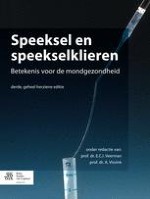2014 | OriginalPaper | Hoofdstuk
3. Eigenschappen van klierspeeksels
Auteurs : E.C.I. Veerman, A.J.M. Ligtenberg
Gepubliceerd in: Speeksel en speekselklieren
Uitgeverij: Bohn Stafleu van Loghum
Samenvatting
-
Speeksel wordt geproduceerd door verschillende typen klieren, die elk een secreet met een karakteristieke biochemische samenstelling uitscheiden.
-
De grote verschillen in samenstelling tussen verschillende klierspeeksels is een van de oorzaken van de variaties in kwantiteit en in kwaliteit van speeksel, zowel binnen een persoon als tussen personen.
-
Factoren die een rol spelen zijn onder andere dag-en-nachtritme, aard en sterkte van de prikkel, psychische toestand, dieet, hormoonspiegels, fysieke activiteit en medicijngebruik.
-
De secretie van parotisspeeksel wordt vooral gestimuleerd door citroenzuur en door kauwen. De secretie van submandibularisspeeksel wordt verhoogd door citroenzuur en door menthol, en minder door kauwen.
-
De viscositeit van klierspeeksels neemt af in de volgorde: sublingualis- → palatum- → submandibularis- → parotisspeeksel.
-
Immuunglobulinen worden door alle speekselklieren uitgescheiden; de kleine speekselklieren leveren een relatief grote bijdrage.
-
De verschillende (sero)mukeuze klieren (gl. sublingualis, gl. submandibularis en de speekselkliertjes in het palatum) secreteren mucinen die biochemisch van elkaar verschillen; kwantitatief leveren deze speekselklieren een ongeveer even grote bijdrage aan de totale concentratie van mucinen in speeksel.
